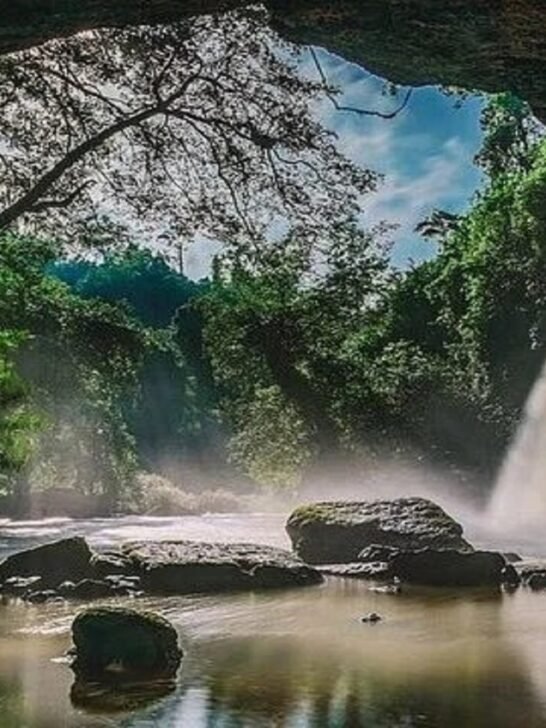Looking for a refreshing escape from the city’s hustle and bustle? Bangkok may be known for its vibrant street life and cultural landmarks, but it’s also surrounded by lush parks, scenic nature trails, and peaceful green spaces—perfect for a weekend family adventure. Whether you're seeking a light stroll with young children or a moderate hike suitable for all ages, these trails offer the perfect balance of fun, fitness, and fresh air. Here are the Top 10 Family-Friendly Nature Trails Near Bangkok that are ideal for nature lovers of all ages.
Hikes Near Bangkok
Table Of Content
- Hikes Near Bangkok
- Top Attractions & Things to Do
- Why Khao Sam Roi Yot Should Be on Your Thailand Itinerary
- 6. Wat Chaloem Phra Kiat Park
- A Park Rooted in History and Royal Legacy
- What to See and Do at Wat Chaloem Phra Kiat Park
- Why Visit Wat Chaloem Phra Kiat Park?
- 7. Mae Klong River Nature Trail
- Top Experiences Along the Trail
- Responsible Travel Tips
- Why Mae Klong River Nature Trail Is Worth the Journey
- 8. Phutthamonthon Park
- Highlights of the Park
- 9. Khlong Lat Mayom Floating Market Area
- What to Expect at Khlong Lat Mayom Floating Market
- Atmosphere and Environment
- Why Khlong Lat Mayom Floating Market Stands Out
- 10. Samut Prakan Ancient City (Muang Boran)
- Overview of Samut Prakan Ancient City (Muang Boran)
- Key Attractions at Samut Prakan Ancient City
- Best Way to Explore Muang Boran
- Tips for a Successful Family Hike Near Bangkok
This blog contains affiliate links, which means I may earn a commission if you make a purchase through these links, at no additional cost to you.
1. Bang Kachao – The “Green Lung” of Bangkok
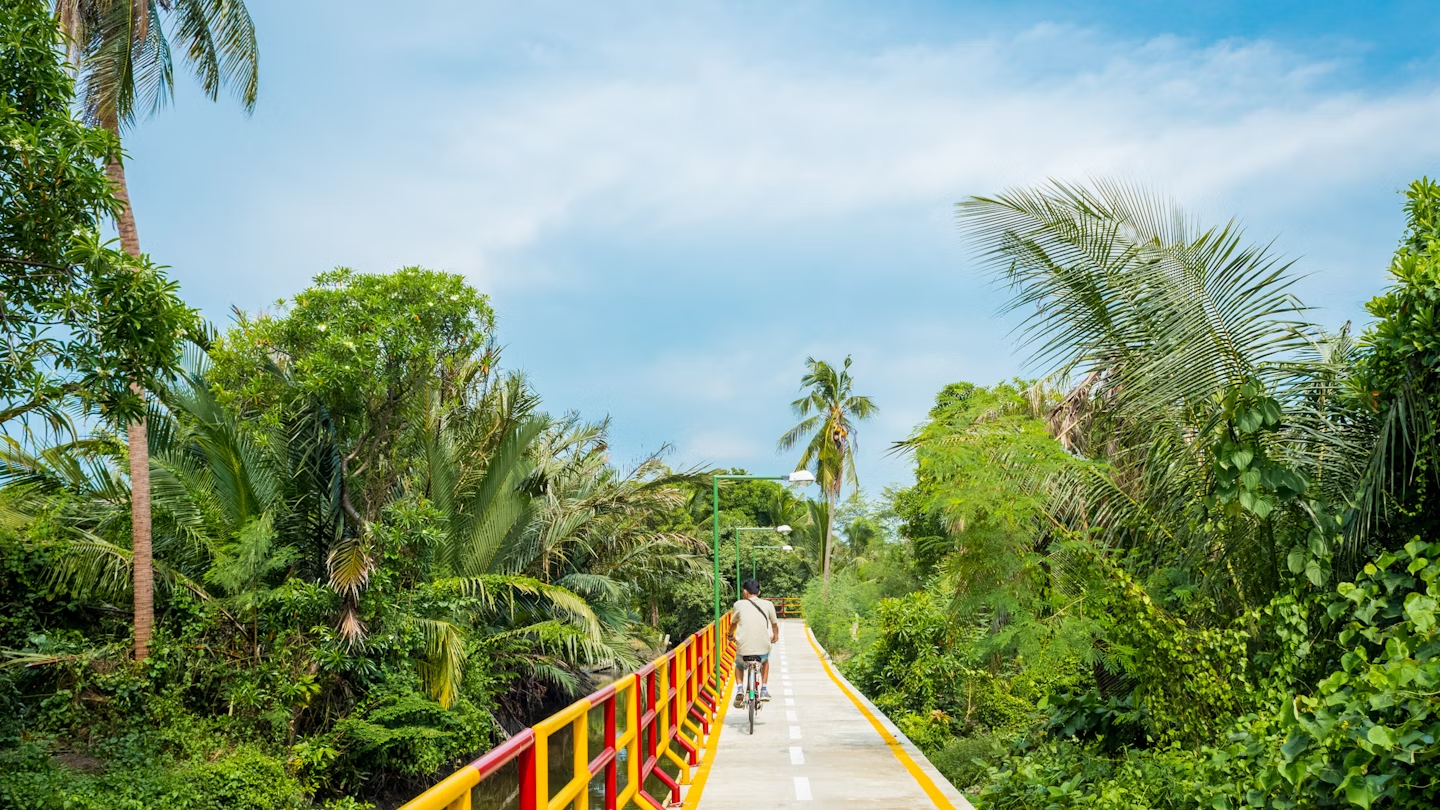
Location: Phra Pradaeng, Samut Prakan
Distance from Bangkok: ~10 km
Often dubbed Bangkok’s “Green Lung,” Bang Kachao is an island of greenery just across the Chao Phraya River. With raised walkways through mangrove forests and small trails winding past gardens and temples, it’s a serene place for biking or light hiking. The Sri Nakhon Khuean Khan Park within Bang Kachao is especially popular for families.
In the midst of Bangkok’s urban sprawl, where skyscrapers dominate the skyline and traffic rarely sleeps, lies a hidden green oasis that feels a world away. Welcome to Bang Kachao – affectionately known as the “Green Lung” of Bangkok. With its lush landscapes, tranquil trails, and eco-conscious charm, this man-made island in the Chao Phraya River offers a rare escape into nature, just minutes from Thailand’s bustling capital.
Whether you're a nature enthusiast, cyclist, photographer, or simply looking for a peaceful retreat with the family, Bang Kachao offers a refreshing breath of fresh air in every sense.
What is Bang Kachao?
Bang Kachao is a large, horseshoe-shaped area located in Phra Pradaeng District, Samut Prakan Province, directly across the river from central Bangkok. Despite its proximity to the city, Bang Kachao has been protected from urban development, preserving over 16 square kilometers of mangrove forests, orchards, canals, and traditional Thai homes.
In 2006, Time Magazine named it the “Best Urban Oasis” in Asia—and it’s not hard to see why.
What Makes Bang Kachao Special?
Preserved Green Space
Bang Kachao is a testament to thoughtful conservation and sustainable urban planning. Local residents and the Thai government have worked together to maintain its natural environment, making it one of the last green lungs in a rapidly developing city.
Cycling & Walking Trails
The island is famous for its elevated walkways and cycling paths that weave through palm groves, banana plantations, and wooden bridges over canals. Bike rental shops are widely available near the ferry piers, offering everything from city bikes to tandem bikes for families.
Canals and Floating Markets
Bang Kachao still maintains a traditional Thai way of life. You’ll spot wooden stilt houses, friendly locals paddling down canals, and even the occasional floating market. The Bang Nam Phueng Floating Market is one of the highlights—offering delicious Thai food, handmade crafts, and locally grown produce.
Sri Nakhon Khuean Khan Park and Botanical Garden
At the heart of Bang Kachao lies this beautifully landscaped park, perfect for a relaxing walk, picnic, or birdwatching session. With its shaded walking paths, lotus ponds, and observation towers, it’s a favorite among families and nature lovers alike.
Top Activities in Bang Kachao
- Rent a bike and explore the maze of peaceful trails.
- Visit Bang Nam Phueng Floating Market (weekends only) for food and culture.
- Stroll through Sri Nakhon Khuean Khan Park for a tranquil nature walk.
- Stop by local temples, like Wat Bang Ko Bua and Wat Rat Rangsan, for a glimpse of local spiritual life.
- Enjoy local cafes nestled among the trees, serving fresh coconut drinks and Thai sweets.
How to Get There
Despite feeling remote, Bang Kachao is surprisingly accessible:
- By BTS Skytrain: Take the BTS to Bang Na or Udom Suk.
- From there, take a taxi to Klong Toei Pier or Wat Bang Na Nok Pier.
- Then, hop on a short boat ride (5–10 minutes) across the Chao Phraya River.
- Once you arrive, bike rental shops are right by the pier.
When to Visit
- Best time: November to February, when the weather is cooler and dry.
- Early mornings are ideal for beating the heat and enjoying quieter trails.
- Weekends are more vibrant (due to the market) but may be a bit busier.
Tips for Visiting Bang Kachao
- Wear light, breathable clothing and bring sunscreen.
- Carry water and insect repellent.
- Most areas accept cash only, so bring some Thai Baht.
- Support local businesses by eating at local food stalls and shopping at the market.
- Respect the peaceful, eco-friendly atmosphere—leave no trace behind.
Why Bang Kachao is a Must-Visit
In a city known for its energy and excitement, Bang Kachao stands as a quiet counterbalance—a place where time slows down and nature takes center stage. It's not just a tourist destination; it's a vital green lung that supports local biodiversity, promotes sustainability, and offers Bangkokians a much-needed connection to the natural world.
Whether you're a local seeking a quick getaway or a visitor looking to see a different side of Bangkok, Bang Kachao delivers serenity, culture, and authenticity in one unforgettable experience.
Why it’s great for families: Shady paths, no steep inclines, and bike rentals available.
Discover unbeatable hotel deals for your next adventure—compare prices and book your perfect stay effortlessly on our platform today!
2. Khao Yai National Park
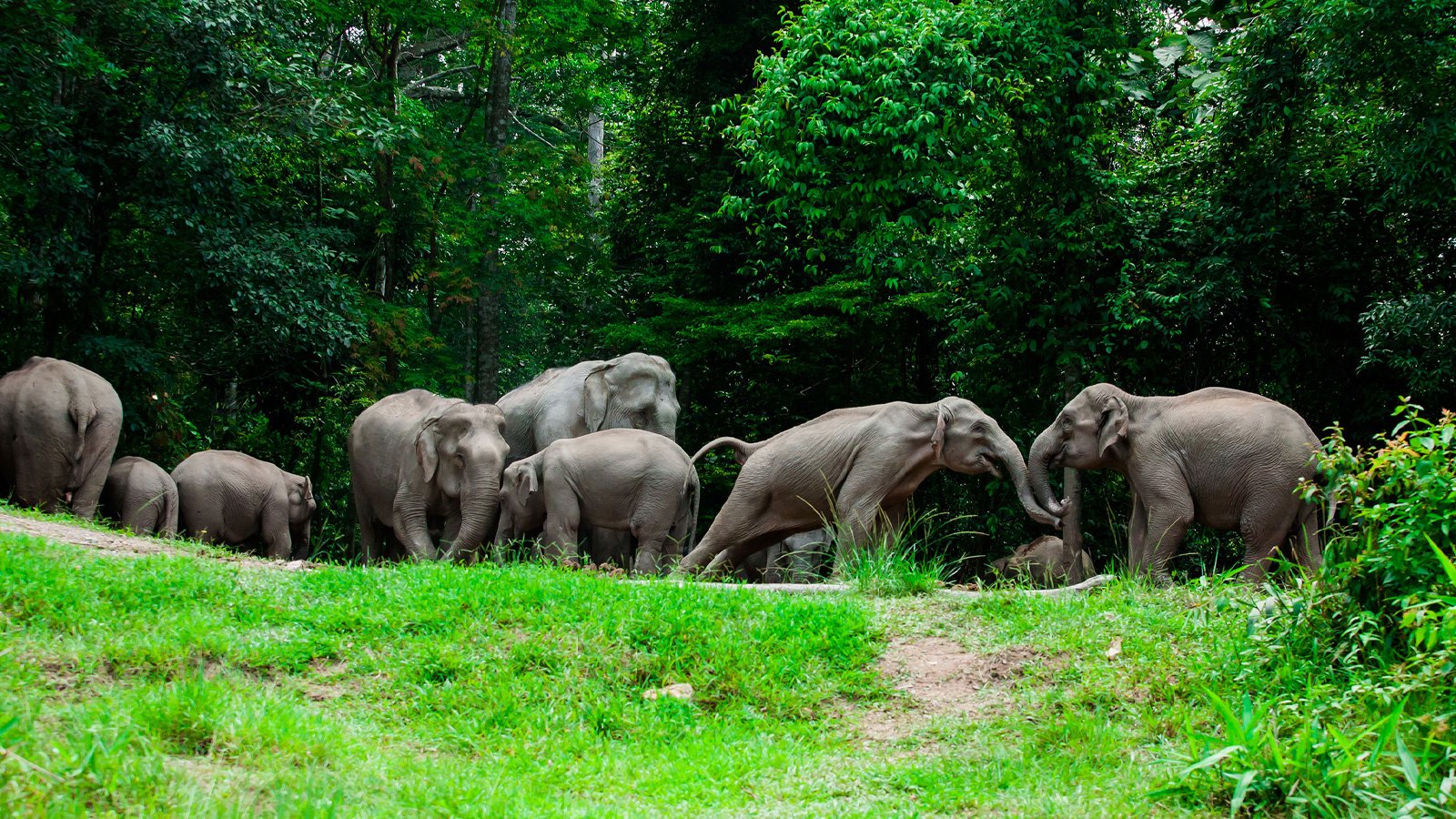
Location: Nakhon Ratchasima
Distance from Bangkok: ~2.5 hours
Thailand’s oldest national park is a UNESCO World Heritage site with well-maintained trails suitable for beginners. Trails like the Kong Kaew Nature Trail (1.2 km) offer an easy trek through rainforest and across hanging bridges.
Just a few hours’ drive from Bangkok lies one of Thailand’s most spectacular natural escapes — Khao Yai National Park. With its misty mountains, lush rainforests, cascading waterfalls, and incredible wildlife, Khao Yai is not just the country’s first national park but remains one of its most beloved and biologically diverse.
Spanning across four provinces — Nakhon Ratchasima, Saraburi, Prachinburi, and Nakhon Nayok — Khao Yai is a UNESCO World Heritage Site and a haven for adventurers, nature lovers, and families alike.
Why Khao Yai National Park is a Must-Visit
Established in 1962, Khao Yai National Park covers over 2,000 square kilometers of pristine wilderness. It is home to evergreen forests, grasslands, and one of the largest intact monsoon forests in Southeast Asia. This biodiverse wonderland shelters more than 300 bird species, 70 species of mammals — including elephants and gibbons — and countless plant and insect species.
Whether you're seeking an adrenaline-packed jungle trek or a quiet moment by a waterfall, Khao Yai has something to offer every type of traveler.
Top Attractions in Khao Yai National Park
Haew Narok Waterfall
The tallest and most dramatic waterfall in the park, Haew Narok is a must-see. A short hike (about 1 km) leads to an observation platform where you can witness the water plummeting over 150 meters down a rugged cliff.
Haew Suwat Waterfall
Famous for its appearance in the movie The Beach, this picturesque waterfall is easily accessible and perfect for photo opportunities. Surrounded by lush jungle, it’s an ideal picnic spot.
Wildlife Watching
Khao Yai offers some of the best wildlife spotting in Thailand. Early mornings or late afternoons are the best times to see elephants, hornbills, gibbons, porcupines, and sambar deer. Wildlife observation towers and guided night safaris offer incredible chances to see animals in their natural habitat.
Nature Trails and Hiking
The park features several marked trails ranging from easy walks to challenging hikes. Popular trails include:
- Kong Kaew Nature Trail (1.2 km) – A family-friendly loop with a suspension bridge.
- Pha Diew Dai Trail (2.5 km) – Leading to a scenic viewpoint with panoramic views.
- 5 km & 8 km Jungle Trails – Best done with a guide; offer chances to spot wild animals and learn about the ecosystem.
Khao Khieo Viewpoint
Located at one of the park’s highest elevations, this viewpoint offers stunning sunrise and sunset vistas over the forest canopy.
Best Time to Visit
- Cool Season (Nov–Feb): Pleasant temperatures, clear skies, and the best time for hiking.
- Green Season (May–Oct): Lush landscapes, flowing waterfalls, and fewer tourists — though some trails may be slippery.
- Hot Season (Mar–May): Dryer and hotter, with increased chances of spotting large animals near water sources.
Park Facilities & Accessibility
- Visitor centers provide maps, trail info, and interpretive displays.
- Campsites and lodges are available for those wishing to stay overnight inside the park.
- Restrooms, parking, and food stalls are available near main attractions.
The park is accessible by car or bus from Bangkok and nearby towns like Pak Chong. Entrance fees apply: ฿400 for foreigners, ฿40 for Thai citizens (subject to change).
Responsible Travel Tips
- Respect wildlife: Do not feed animals or approach them.
- Leave no trace: Carry out all trash and stay on marked trails.
- Hire local guides: They provide safety, insight, and support conservation efforts.
- Avoid plastic: Bring reusable bottles and containers.
Beyond the Park: Khao Yai Region Highlights
The area surrounding Khao Yai National Park has grown into a charming countryside destination with wineries, organic farms, cafes, and European-inspired resorts. Notable spots include:
- PB Valley and GranMonte Vineyards – Thailand’s leading wine producers.
- Primo Piazza and The Chocolate Factory – Perfect for family-friendly experiences.
- The Birder’s Lodge and local art cafes – Blend nature with creativity and great food.
Why it’s great for families: Easy, guided hikes available; chances to see wildlife like gibbons and hornbills.
3. Suan Rot Fai (Railway Park)
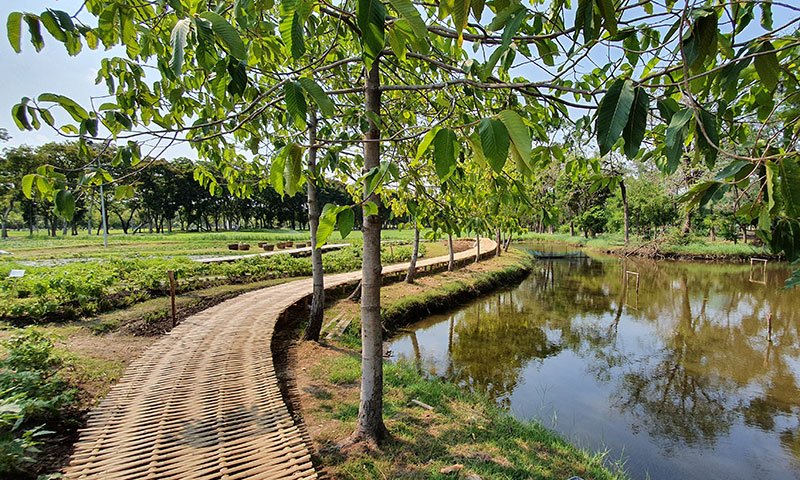
Location: Chatuchak, Bangkok
Distance from central Bangkok: Within city
A hidden gem inside the city, Suan Rot Fai offers shaded trails that are great for walking, biking, and even paddle boating. Families love the butterfly garden and playground areas.
In the heart of bustling Bangkok, where modern skyscrapers and endless traffic dominate the scene, lies a peaceful sanctuary that locals cherish and travelers often discover with delight — Suan Rot Fai, also known as the Railway Park. This hidden gem offers a refreshing green escape where families, cyclists, joggers, and nature lovers come to breathe, relax, and reconnect with the outdoors.
Whether you're looking for a leisurely weekend stroll, a place to picnic with kids, or a scenic cycling trail, Suan Rot Fai provides the perfect setting — all within easy reach of the city center.
What is Suan Rot Fai?
Suan Rot Fai, which translates to “Railway Park,” was once the State Railway of Thailand’s golf course. Today, it has been transformed into one of Bangkok’s most beloved public parks. Located adjacent to Chatuchak Park and Queen Sirikit Park, it forms part of a massive green complex often referred to as the “Green Lungs of Bangkok.”
Covering approximately 150 acres, the park is a haven for outdoor activities, rich in flora and fauna, and remarkably quiet for such a central location.
Top Attractions and Activities at Suan Rot Fai
Cycling Trails
Suan Rot Fai is famous for its 3-kilometer scenic bike loop that winds through tree-lined paths, open fields, and shaded bridges. Bikes can be rented at the entrance for a minimal fee, making it easy for tourists and locals to explore the park at their own pace.
Butterfly Garden and Insectarium
One of the highlights for families is the Bangkok Butterfly Garden and Insectarium, located inside the park. This educational facility showcases dozens of butterfly species in a netted dome filled with tropical plants and flowers. It’s both enchanting and informative — a favorite among children and nature enthusiasts.
Jogging and Walking Paths
For those who prefer a slower pace, Suan Rot Fai offers well-paved paths ideal for walking, jogging, or simply enjoying the peaceful surroundings. Benches, water stations, and shady trees make it perfect for early morning or evening exercise.
Birdwatching and Wildlife
Thanks to its diverse ecosystem and proximity to Queen Sirikit Park’s botanical gardens, Suan Rot Fai attracts a surprising variety of birds and small animals. Birdwatchers often visit in the early hours to catch a glimpse of species such as kingfishers, herons, and cuckoos.
Pond Activities and Picnic Spots
Several small lakes and ponds dot the park, offering tranquil views and opportunities to rent paddle boats. Surrounding these water features are open lawns ideal for picnics, yoga, or just lounging with a book under a tree.
How to Get There
- Location: Chatuchak District, Bangkok
- BTS: Mo Chit Station
- MRT: Chatuchak Park Station
- From either station, it’s a short walk to the park entrance via Chatuchak Park.
Park Facilities
- Bike rentals at the park entrance
- Restrooms and drinking fountains throughout the grounds
- Food stalls and vendors selling snacks, drinks, and local treats
- Parking available for those arriving by car
- Free entry to the park (but some attractions may have nominal fees)
Best Time to Visit
- Morning (6 AM – 9 AM): Cooler temperatures and fewer visitors make this the ideal time for exercise or a peaceful walk.
- Evening (4 PM – 6:30 PM): Great for watching the sunset and enjoying cooler weather after the midday heat.
- Weekdays are quieter, while weekends bring more families and local visitors.
Tips for a Great Experience
- Bring sunscreen, a hat, and insect repellent, especially if staying for long hours.
- Pack a picnic blanket if you plan to lounge or eat outdoors.
- For photography lovers, the golden hour around sunrise and sunset offers beautiful lighting.
- Respect the park’s eco-friendly atmosphere — no littering or loud music.
Why Suan Rot Fai is Worth a Visit
In a city as dynamic and fast-paced as Bangkok, Suan Rot Fai stands out as a rare green refuge that’s accessible, family-friendly, and wonderfully maintained. Its blend of nature, recreation, and community makes it more than just a park — it’s a place where city life slows down and simple pleasures shine.
Whether you're a tourist looking to escape the urban grind or a local in search of a weekend retreat, Suan Rot Fai invites you to relax, explore, and rediscover the joy of nature in the middle of the metropolis.
Why it’s great for families: Safe, enclosed, and lots of activities for kids.
Looking for budget-friendly flights or all-in-one travel packages? Check out our top picks and start planning your perfect getaway today!
4. Erawan National Park
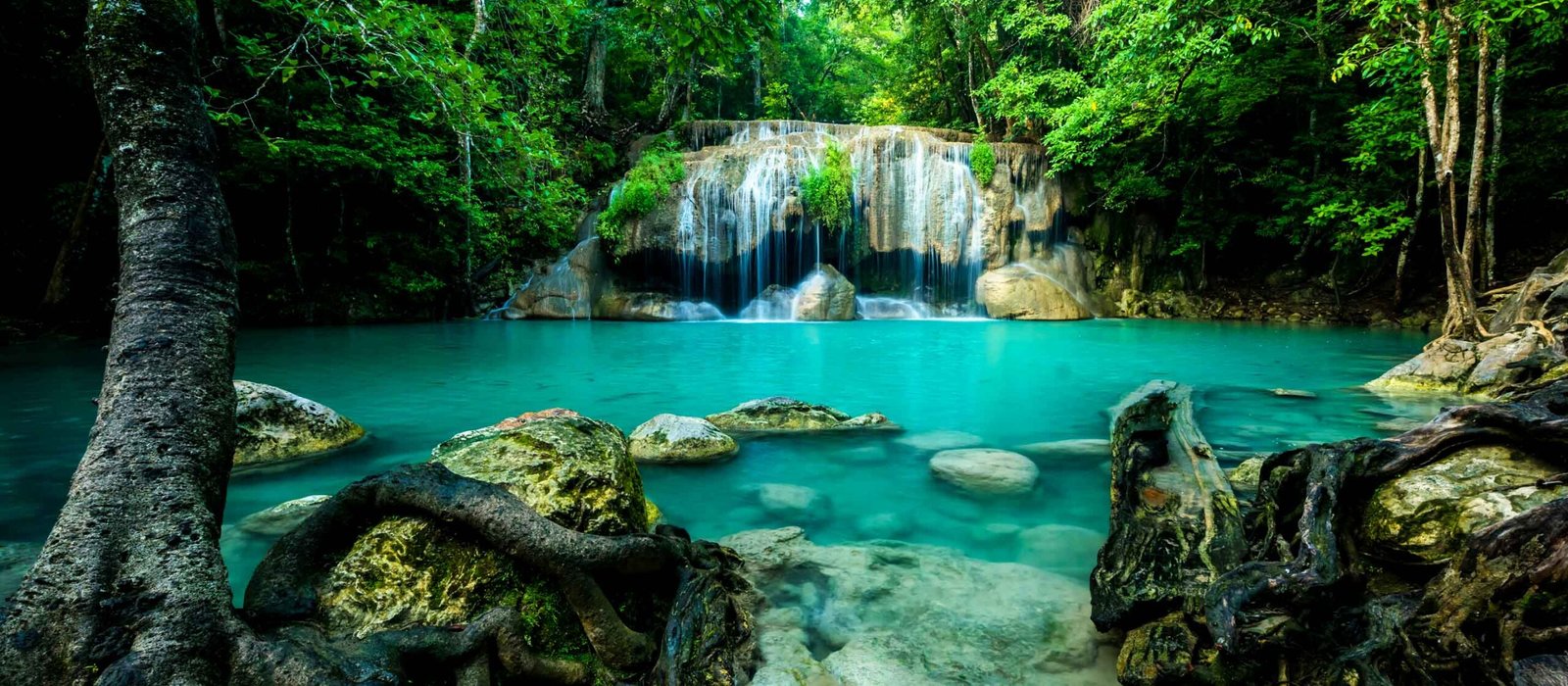
Location: Kanchanaburi
Distance from Bangkok: ~3 hours
Known for its stunning seven-tiered waterfall, this park offers a scenic trail that follows the cascading waters. While the full trail may be a bit steep near the top, the lower levels are easily accessible.
Tucked away in the lush hills of Kanchanaburi Province, about three hours northwest of Bangkok, lies one of Thailand’s most iconic natural wonders — Erawan National Park. With its crystal-clear waterfalls, limestone caves, dense forests, and diverse wildlife, Erawan is a must-visit destination for anyone seeking a true escape into nature.
Named after the three-headed white elephant from Hindu mythology, Erawan National Park is as mythical in beauty as its name suggests. Whether you’re planning a day trip or a weekend adventure, this park promises unforgettable moments at every turn.
Overview of Erawan National Park
- Established: 1975 (Thailand’s 12th national park)
- Location: Kanchanaburi Province, western Thailand
- Size: Approximately 550 square kilometers
- Famous For: The seven-tiered Erawan Waterfall, turquoise pools, caves, and trekking trails
Erawan National Park is part of the Western Forest Complex, one of Southeast Asia’s most significant wildlife sanctuaries. It offers a stunning blend of tropical rainforest and deciduous forest, ideal for trekking, swimming, and wildlife observation.
Top Attractions in Erawan National Park
The Seven-Tiered Erawan Waterfall
The crown jewel of the park, the Erawan Waterfall, is a cascading wonder of nature. Spanning seven tiers over 1.5 kilometers, each level offers something unique — from emerald-blue pools perfect for swimming to dramatic limestone cascades and tranquil picnic spots.
- Tier 1–3: Easy to access and family-friendly
- Tier 4–7: More challenging but rewarding with fewer crowds and better views
- Look out for fish swimming in the pools — especially the famous Garra rufa, also known as “spa fish”
Nature Trails and Hiking
For those craving more adventure, several hiking trails wind through the park. The main waterfall trail is well-marked, while deeper forest paths offer opportunities for guided treks and birdwatching.
- Level of difficulty: Moderate
- Duration: 1.5–3 hours depending on the number of tiers you visit
- Tips: Wear good hiking shoes and bring water, as the upper tiers require climbing over rocks and roots
Caves to Explore
Erawan is also home to several fascinating caves:
- Phartat Cave: Features ancient rock formations and is the most popular
- Wang Bah Dan Cave: Offers deep caverns and hidden chambers
- Mi Cave and Ta Duang Cave: Ideal for adventurous travelers interested in geology and history
These caves are generally accessible by car and short hikes and may require a guide for entry.
Wildlife Watching
Erawan’s forest ecosystem is home to diverse species, including:
- Asian elephants, gibbons, deer, and wild boars
- Over 120 species of birds, including hornbills, kingfishers, and woodpeckers
- Reptiles, butterflies, and exotic insects — ideal for nature photographers
How to Get There
- From Bangkok:
- 1. By car: ~3 hours via Route 323
- 2. By train or bus to Kanchanaburi, then local transport or rental car
- From Kanchanaburi Town:
- 1. Minivans, songthaews (shared taxis), and rental motorbikes are available
- 2. Park entrance is about 65 km from town
Park Information
- Opening Hours: 8:00 AM – 4:30 PM daily
- Entrance Fees:
- 1. Foreigners: 300 THB (adults), 200 THB (children)
- 2. Thai Nationals: 100 THB (adults), 50 THB (children)
- Facilities:
- 1. Restrooms, parking, picnic areas
- 2. Food stalls and drink vendors at the base of the waterfall trail
- 3. Tent camping and bungalows available for overnight stays (advanced booking recommended via DNP website)
Best Time to Visit
- November to February (Cool Season): Ideal weather, clear skies, perfect for trekking and photography
- March to May (Hot Season): Great for swimming but can be very warm
- June to October (Rainy Season): Lush greenery and strong waterfall flow, but trails may be slippery
Eco-Tips for Visiting Erawan National Park
- No single-use plastics: The park enforces a no-plastic policy — bring reusable bottles
- Take nothing but photos: Do not remove rocks, plants, or disturb wildlife
- Stay on trails: For safety and conservation reasons
- Use biodegradable sunscreen: Protect the sensitive aquatic ecosystem
- Carry your trash out: Help preserve the park’s natural beauty
Why Erawan National Park Should Be on Your Travel List
Erawan National Park is more than just a scenic destination — it’s a rare blend of relaxation and adventure, of natural beauty and ecological integrity. Whether you're cooling off in a turquoise pool, hiking through dense jungle, or exploring ancient caves, the park offers a profound connection to Thailand’s wild heart.
For families, couples, solo travelers, and eco-tourists alike, Erawan is a place to unwind, recharge, and witness nature at its most serene and spectacular.
Why it’s great for families: Swimming areas at each waterfall tier and picnic spots along the way.
5. Khao Sam Roi Yot National Park
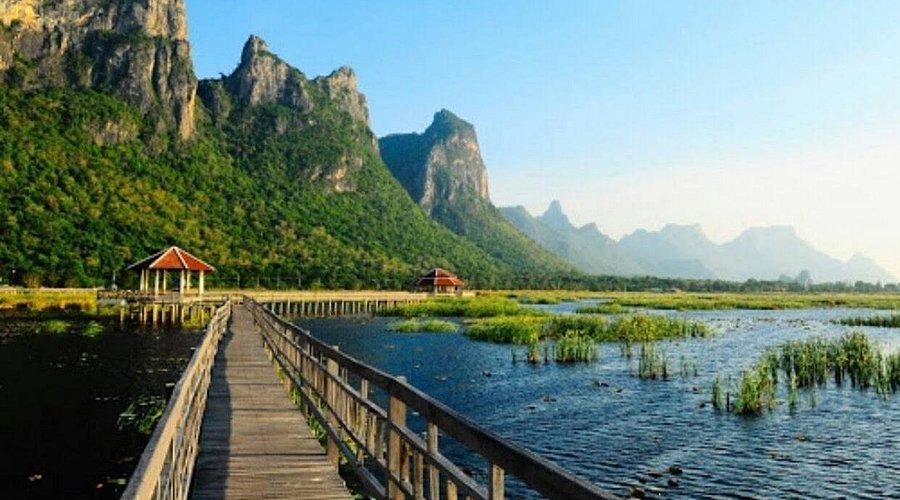
Location: Prachuap Khiri Khan
Distance from Bangkok: ~3.5 hours
Home to the famous Phraya Nakhon Cave, this park offers flat trails through wetlands and mangroves, perfect for birdwatching and exploring.
Nestled along the Gulf of Thailand in Prachuap Khiri Khan Province, just a few hours south of Bangkok, lies one of Thailand’s most breathtaking natural destinations — Khao Sam Roi Yot National Park. Known as the “Mountain with Three Hundred Peaks,” this coastal gem offers a mesmerizing combination of limestone mountains, hidden beaches, freshwater marshes, and the iconic Phraya Nakhon Cave.
Whether you're a nature lover, hiker, photographer, or cultural explorer, Khao Sam Roi Yot (pronounced Khao Sam Roy Yot) promises an immersive escape into landscapes that are as dramatic as they are diverse.
Overview of Khao Sam Roi Yot National Park
- Established: 1966 (Thailand’s first coastal national park)
- Location: About 60 km south of Hua Hin, Prachuap Khiri Khan
- Size: Approximately 98 square kilometers
- Notable For: Limestone karsts, Phraya Nakhon Cave, wetland ecosystems, birdwatching
Khao Sam Roi Yot is a stunning showcase of Thailand’s natural variety — from rugged peaks to mangrove forests and secluded bays. Its name, which translates to “The Mountain with Three Hundred Peaks,” hints at the dramatic karst terrain that defines the park's skyline.
Top Attractions & Things to Do
Phraya Nakhon Cave – The Park’s Crown Jewel
Arguably the most iconic landmark in the park, Phraya Nakhon Cave is a magical cavern illuminated by a natural skylight. Nestled inside is the Khuha Kharuehat Pavilion, a royal structure built for King Rama V in the 19th century.
- Getting there: A short boat ride (or hike) to Laem Sala Beach, followed by a 30-minute steep hike up to the cave
- Best time to visit: Morning (around 10 AM) when sunlight streams through the roof, illuminating the pavilion
Thung Sam Roi Yot Freshwater Marsh
One of Thailand’s largest freshwater marshes, this wetland area is crucial for biodiversity and a major attraction for birdwatchers.
- Home to over 300 bird species, including herons, egrets, and migratory birds
- Wooden boardwalks and observation towers offer excellent viewing points, especially during the cool season (Nov–Feb)
Sam Phraya and Laem Sala Beaches
These quiet, scenic beaches are framed by mountains and ideal for relaxing after a hike or cave visit. Soft sands and gentle waves make them perfect for a low-key seaside escape.
Khao Daeng Viewpoint
A short but steep hike rewards visitors with panoramic views of limestone peaks, marshlands, and the sea. Best visited at sunrise or sunset for dramatic light.
Khao Daeng Canal Boat Tour
Explore mangrove forests and spot wildlife such as monkeys, monitor lizards, and kingfishers on a peaceful boat ride through the Khao Daeng Canal.
Best Time to Visit
- November to February (Cool Season): Ideal for hiking, wildlife watching, and cave exploration
- March to May (Hot Season): Warmest period; beaches and sea breezes offer respite
- June to October (Rainy Season): Lush landscapes and fewer crowds, but trails may be slippery
How to Get There
- From Bangkok:
- 1. By car: ~3.5-hour drive via Route 35 and 4
- 2. By train or bus to Hua Hin or Pranburi, then local transport or taxi to the park
- From Hua Hin:
- 1. Approx. 1-hour drive to the park entrance
- 2. Motorbikes or private taxis can be hired for day trips
Facilities & Park Information
- Opening hours: 6:00 AM – 6:00 PM daily
- Entry fee:
- 1. Foreigners: 200 THB (adults), 100 THB (children)
- 2. Thai citizens: 40 THB (adults), 20 THB (children)
- Facilities include:
- 1. Park HQ with maps and guides
- 2. Restrooms, restaurants, and food stalls at key locations
- 3. Tent camping and bungalows available at Sam Phraya Beach and HQ area
Responsible Travel Tips
- Respect the cave and natural formations — don’t touch or climb on the pavilion
- Use reusable water bottles and avoid single-use plastics
- Stick to designated trails to protect fragile ecosystems
- Avoid feeding wildlife and keep a respectful distance
- Dress modestly and appropriately, especially in cultural sites
Why Khao Sam Roi Yot Should Be on Your Thailand Itinerary
Khao Sam Roi Yot National Park is where mountains meet the sea, where caves hold royal secrets, and where wetlands come alive with birdsong. It’s a rare blend of adventure, tranquility, and natural beauty, offering something for every kind of traveler.
Far from the crowds yet easy to reach, this coastal paradise is a testament to Thailand’s wild, untamed heart — and a place where memories are made beneath limestone peaks and golden rays of sunlight streaming into ancient caves.
Why it’s great for families: Variety of trails, boat rides available, and scenic photo spots.
Find the best hotel deals for your next trip—compare prices from top sites and book your perfect stay all in one place!
6. Wat Chaloem Phra Kiat Park
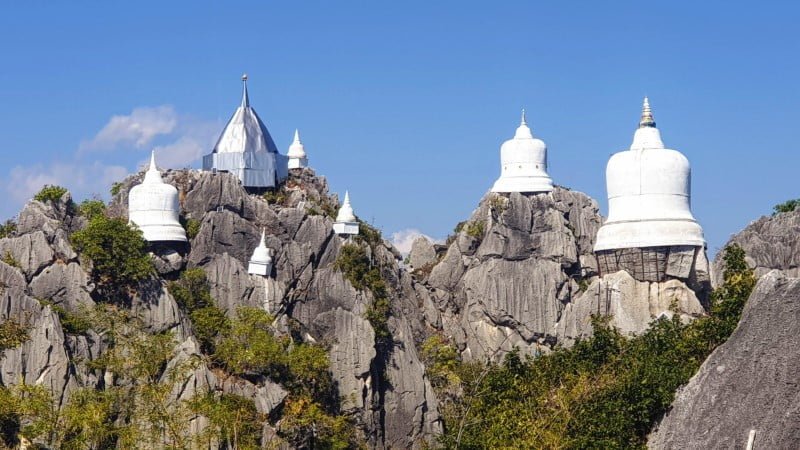
Location: Nonthaburi
Distance from Bangkok: ~30 minutes
This lesser-known riverside park offers peaceful walking paths shaded by old trees. The adjacent temple and ponds provide a cultural and calming atmosphere.
Just a short drive from the hustle and bustle of Bangkok lies a peaceful, lesser-known sanctuary that blends Thai heritage with natural serenity — Wat Chaloem Phra Kiat Park. Located in Nonthaburi Province, this riverside retreat offers a unique combination of scenic beauty, cultural richness, and community atmosphere, making it a perfect destination for a relaxed day trip from the city.
Whether you're a local seeking a quiet spot to unwind or a traveler interested in authentic Thai experiences off the tourist trail, Wat Chaloem Phra Kiat Park is a hidden gem well worth discovering.
A Park Rooted in History and Royal Legacy
Situated beside the historic Wat Chaloem Phra Kiat Worawihan, the park was developed as a tribute to the Thai monarchy and to provide the public with a green, accessible recreational space along the Chao Phraya River. With manicured gardens, elegant pavilions, and waterfront walkways, it strikes a beautiful balance between natural design and cultural reverence.
The adjacent temple, Wat Chaloem Phra Kiat, was commissioned in the 19th century by King Rama III, adding historical and architectural depth to the park’s surroundings.
What to See and Do at Wat Chaloem Phra Kiat Park
Stroll Along the Riverside Promenade
The park’s most captivating feature is its peaceful riverfront walkway, lined with flowering trees and scenic viewpoints overlooking the Chao Phraya River. Benches and shaded pavilions invite visitors to pause, take in the view, and watch boats drift by.
Explore the Ornamental Gardens
Designed with traditional Thai landscaping in mind, the park’s gardens are filled with colorful blooms, trimmed hedges, and lotus ponds. Seasonal flowers and fragrant tropical plants make this area a delight for photographers and nature lovers alike.
Visit Wat Chaloem Phra Kiat Worawihan
Take a moment to explore the adjacent temple, known for its striking white walls, gold-trimmed chedis, and ornate viharn (prayer hall). Its peaceful ambiance, historical murals, and riverside location make it one of Nonthaburi’s most significant — yet underappreciated — temples.
Enjoy Leisure Activities
- Cycling paths wind through the park, perfect for a relaxed ride.
- Children’s playgrounds and open lawns make it family-friendly.
- Locals often practice tai chi or group aerobics in the mornings and evenings.
Capture the Sunset
In the late afternoon, the park transforms as the sun begins to set over the Chao Phraya. It’s one of the best spots in Nonthaburi for a golden-hour photo session or a romantic riverside moment.
How to Get There
- Location: Bang Si Mueang Subdistrict, Mueang Nonthaburi District, Nonthaburi
- From Bangkok:
- 1. By car or taxi: ~30–45 minutes depending on traffic
- 2. By MRT: Take the Purple Line to Bang Phlu or Yaek Nonthaburi 1, then a short taxi or motorcycle ride
- 3. By river: Some local boat services run nearby (check for current schedules)
Park Information
- Opening hours: Daily from 5:00 AM – 8:00 PM
- Entry: Free to the public
- Facilities:
- 1. Clean restrooms
- 2. Parking spaces
- 3. Food vendors and local eateries nearby
- 4. Wheelchair-accessible walkways
Why Visit Wat Chaloem Phra Kiat Park?
Unlike the more crowded city parks of Bangkok, Wat Chaloem Phra Kiat Park offers a tranquil, authentic Thai atmosphere, rich with cultural heritage and natural beauty. It’s a place where families picnic, elders meditate, and visitors get a taste of local life along the Chao Phraya River.
Its proximity to the capital, scenic design, and cultural significance make it a perfect off-the-beaten-path destination — ideal for reflection, photography, and slow travel.
Insider Tips for Your Visit
- Visit early in the morning for cooler temperatures and fewer visitors.
- Bring water, sunscreen, and a hat — shade is available, but much of the park is open.
- Combine your trip with nearby attractions in Nonthaburi such as Ko Kret or Nonthaburi Market.
- Be respectful when entering the temple — modest dress is required.
Why it’s great for families: Easy to access, very quiet, and close to the city.
7. Mae Klong River Nature Trail
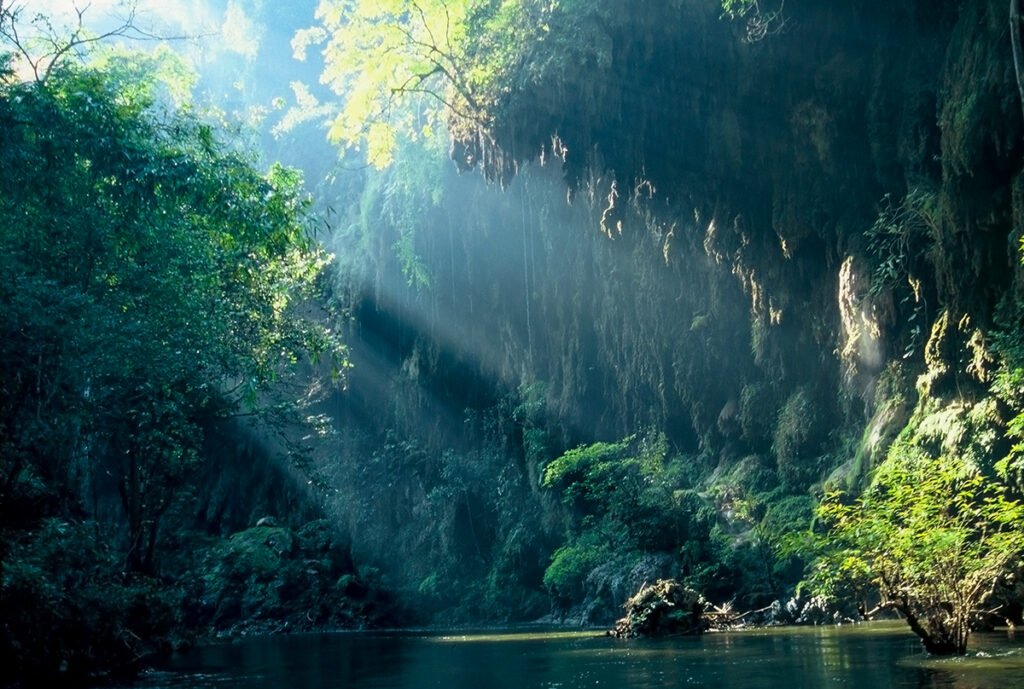
Location: Samut Songkhram
Distance from Bangkok: ~1.5 hours
A picturesque riverside trail that takes you through mangrove forests and local fishing communities. Great for a leisurely half-day trip.
Nestled within the heart of Ratchaburi Province, just a short drive from Bangkok, the Mae Klong River Nature Trail offers a peaceful escape into one of Thailand’s most culturally and ecologically rich landscapes. This serene riverside path invites visitors to experience the gentle rhythm of local life, scenic beauty, and environmental harmony — all along one of the country’s most historic rivers.
Whether you're a casual walker, birdwatcher, photographer, or eco-tourist, this trail provides a rewarding blend of nature, culture, and relaxation just a few hours from the capital.
Overview of the Mae Klong River Nature Trail
- Location: Ratchaburi Province, Western Thailand
- Trail Type: Riverside walkway and eco-trail
- Length: Varies by segment; typically 2–5 km sections
- Highlights: River views, mangrove forests, traditional communities, birdwatching, eco-rest stops
The Mae Klong River — known for its calm waters and scenic banks — has long supported local agriculture, fishing communities, and river commerce. The nature trail developed along its banks honors both this heritage and the ecological richness of the river environment.
Top Experiences Along the Trail
Riverside Serenity
The nature trail follows the meandering path of the Mae Klong River, offering panoramic views of the water, traditional stilted homes, and the occasional long-tail boat. The peaceful atmosphere makes it ideal for a mindful walk or morning jog.
Birdwatching and Wildlife Observation
The trail passes through wetland zones and lowland forest areas, attracting a variety of birds and small wildlife. Look out for:
- Herons, egrets, and kingfishers
- Colorful butterflies and dragonflies
- Native flora, including mangrove trees and water hyacinths
Guided eco-tours may be available seasonally for birdwatching enthusiasts.
Cultural Stops & Local Villages
Along the trail, visitors may encounter:
- Floating markets and riverside communities
- Small shrines and wooden temples
- Local artisans selling handmade crafts or traditional sweets
It’s not just a nature trail — it’s a cultural corridor, connecting visitors with the enduring traditions of central Thai river life.
Eco-Rest Areas and Educational Signs
Several rest stations are integrated into the trail with bamboo shelters, benches, and educational signage explaining local plant species, aquatic ecosystems, and conservation efforts. These make the walk informative and family-friendly.
How to Get There
- From Bangkok:
- 1. By car: ~1.5–2 hours via Route 35 and 3090
- 2. By train: Take a train from Bangkok to Ratchaburi Station, then a short taxi ride
- 3. By bus or minivan from the Southern Bus Terminal (Sai Tai Mai) to Ratchaburi town
- Local Access Points: The nature trail can be accessed near community areas along the river such as Pak Tho or Baan Pong.
Visitor Information
- Opening Hours: Generally open daily from sunrise to sunset
- Entry Fee: Free for all visitors
- Amenities:
- 1. Parking areas near main access points
- 2. Toilets and rest huts
- 3. Local food stalls and community cafés nearby
Best Time to Visit
- November to February: Cool and dry weather, perfect for walking and birdwatching
- March to May: Hotter season; bring sun protection and water
- June to October: Green and lush, but trails may be slippery after rain
Responsible Travel Tips
- Bring a reusable water bottle and avoid single-use plastics
- Stay on marked paths to protect delicate ecosystems
- Don’t feed wildlife or remove plants
- Support local communities by purchasing food or handmade items
- Use eco-friendly insect repellent and sunscreen near the river
Why Mae Klong River Nature Trail Is Worth the Journey
In a country famed for dramatic mountains and tropical islands, the Mae Klong River Nature Trail offers a different kind of beauty — quiet, authentic, and deeply rooted in local life. It’s an ideal day trip for those looking to reconnect with nature, appreciate Thai river culture, and take a break from the fast pace of urban travel.
Whether you’re a solo traveler seeking peace, a couple looking for a scenic walk, or a family wanting an educational nature outing, this trail welcomes you with open skies, open water, and open hearts.
Why it’s great for families: Flat terrain and educational opportunities about local ecology.
Find the best hotel deals for your next trip—compare prices across top travel sites and book your ideal stay instantly on [travelbloger.net]!
8. Phutthamonthon Park
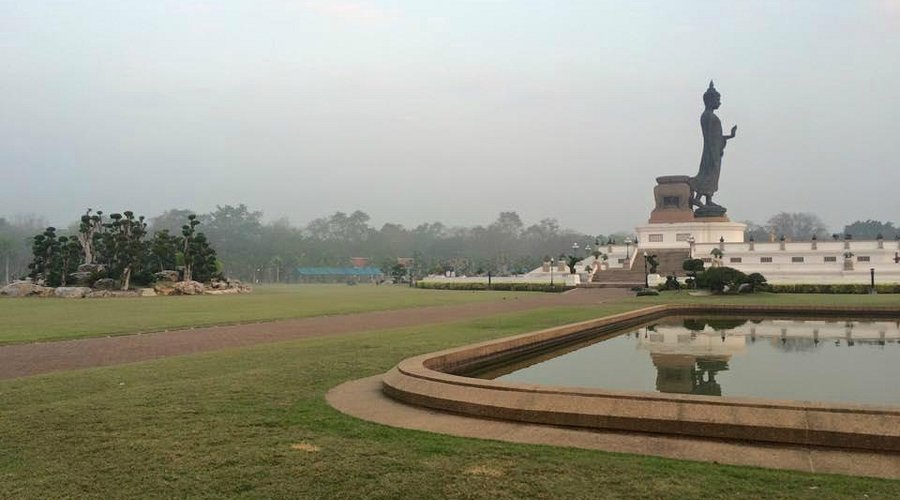
Location: Nakhon Pathom
Distance from Bangkok: ~1 hour
A sprawling park with wide walking paths, serene ponds, and the tallest walking Buddha statue in the world. The grounds are well maintained and ideal for picnics.
Just west of Bangkok in Nakhon Pathom Province, Phutthamonthon Park (also spelled "Buddhamonthon") stands as a serene sanctuary where Buddhism, nature, and design harmoniously converge. Spanning over 2,500 acres, it is one of the largest Buddhist parks in the world, offering a peaceful escape from the city while inviting reflection, spiritual exploration, and relaxation in a beautifully landscaped setting.
Whether you’re a devout pilgrim, a casual visitor, or a nature lover seeking serenity, Phutthamonthon Park promises an enriching experience that goes far beyond the ordinary.
An Overview of Phutthamonthon Park
- Location: Salaya District, Nakhon Pathom (approximately 25 km west of central Bangkok)
- Established: 1957, to commemorate the 2,500th anniversary of the birth of Buddhism
- Size: 2,500 acres (around 4 square kilometers)
- Managed by: Thai government and the Buddhist Sangha
The park was designed as a spiritual and educational center, aiming to preserve and promote Buddhist philosophy through art, architecture, and landscape design.
Highlights of the Park
The Great Walking Buddha Statue
The park’s centerpiece is a towering 15.87-meter bronze statue of the Walking Buddha, created by renowned sculptor Professor Corrado Feroci (Silpa Bhirasri). It is one of the most iconic representations of the Buddha in motion, symbolizing grace, compassion, and enlightenment.
The statue stands on a high pedestal, surrounded by a lotus pond and encircled by a wide walking path — a popular spot for walking meditation.
Four Noble Truths and Noble Eightfold Path Monuments
Engraved in stone around the main Buddha image are tablets illustrating the Four Noble Truths and the Noble Eightfold Path — the core teachings of Buddhism. These features serve both an educational and contemplative purpose, making the park a living textbook of spiritual wisdom.
Lush Gardens and Serene Waterways
The park is meticulously landscaped with manicured gardens, serene lotus ponds, tree-lined paths, and open green spaces ideal for picnics, reading, or quiet reflection.
You’ll find:
- Shady walkways for walking or jogging
- Birdwatching opportunities around the ponds
- Seasonal flowers and fragrant frangipani trees
- Pavilions and bridges for photography and relaxation
Viharn and Dharma Pavilions
Several pavilions are scattered throughout the park, offering spaces for prayer, sermons, and meditation. These architectural gems combine traditional Thai design with modern simplicity, enhancing the spiritual atmosphere.
Why Visit Phutthamonthon Park?
- Spiritual Experience: Ideal for meditation, prayer, and learning about Buddhist philosophy.
- Nature Escape: Enjoy fresh air and tranquil landscapes without leaving the Bangkok metro area.
- Cultural Learning: See one of Thailand’s most significant representations of the Buddha and explore Buddhist teachings in physical form.
- Family-Friendly: Spacious grounds, safety, and cleanliness make it suitable for families, students, and elderly visitors alike.
How to Get There
- By Car: ~45 minutes from central Bangkok via Borommaratchachonnani Road (Route 338)
- By Public Transport:
- 1. Bus: Several buses and vans run from Bangkok to Salaya
- 2. Train: Take a train from Bangkok Railway Station (Hua Lamphong) to Salaya Station, then a short taxi or tuk-tuk ride
- Nearby Attractions:
- 1. Mahidol University’s beautiful campus
- 2. Thai Human Imagery Museum
- 3. Sanam Chandra Palace
Visitor Information
- Opening Hours: Daily, 5:00 AM – 7:00 PM
- Entrance Fee: Free for all visitors
- Facilities:
- 1. Parking areas
- 2. Restrooms and resting pavilions
- 3. Local food stalls and drink vendors near the entrances
- 4. Wheelchair-accessible paths
Responsible Visitor Tips
- Dress modestly when visiting spiritual areas
- Remain respectful around people meditating or praying
- Do not litter — help preserve the peaceful environment
- Refrain from loud music or disruptive behavior
- Participate mindfully if engaging in meditation or ceremonies
Why it’s great for families: Safe, open spaces and a peaceful vibe.
9. Khlong Lat Mayom Floating Market Area
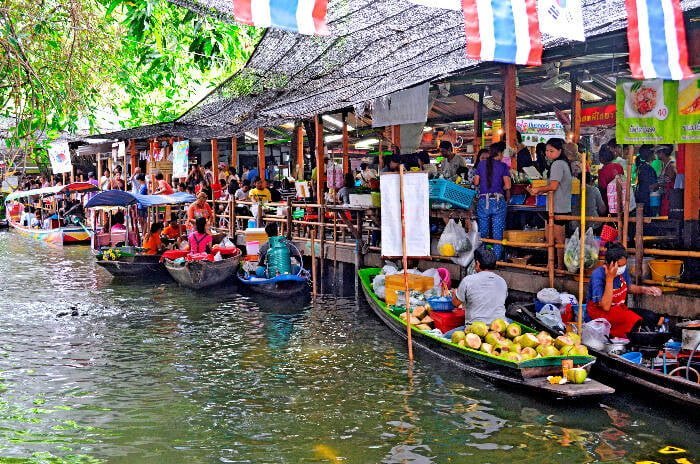
Location: Taling Chan, Bangkok
Distance from central Bangkok: ~30 minutes
This isn’t a traditional hiking trail, but a walk through this floating market and surrounding khlong-side paths is a fun and educational outdoor experience. Combine it with a boat tour for added excitement.
Just a short drive from Bangkok’s busy streets, nestled in the Thonburi District, lies the picturesque and peaceful Khlong Lat Mayom Floating Market Area. Less commercialized than its famous counterparts like Damnoen Saduak or Amphawa, this charming market offers an authentic glimpse into the traditional way of life along Thailand’s waterways.
For those seeking a more genuine floating market experience with less hustle and more local flair, Khlong Lat Mayom is the ideal destination. Here, visitors can explore the waterways, sample delicious local dishes, and immerse themselves in the tranquil atmosphere of this riverside community.
Overview of Khlong Lat Mayom Floating Market Area
- Location: Thonburi, Bangkok (approximately 30-40 minutes from central Bangkok)
- Established: Around 1997
- Operating Hours: Saturdays and Sundays, 8:00 AM – 4:00 PM
- Vibe: Laid-back, authentic, community-driven, local
The market is set along the Khlong Lat Mayom canal, where boats selling fresh produce, traditional Thai snacks, and local handicrafts glide peacefully along the water. Unlike the more touristy floating markets, Khlong Lat Mayom is beloved by locals, making it the perfect spot for those wanting to experience Thai culture in an authentic, unhurried setting.
What to Expect at Khlong Lat Mayom Floating Market
Boat Ride Experience
One of the main attractions of Khlong Lat Mayom is the chance to take a boat ride along the canal. For a small fee, you can hire a boat and glide through the peaceful waters, passing traditional wooden houses and lush greenery. The boat ride offers a unique perspective of the local way of life, as you see villagers living by the water, tending to their gardens, and going about their daily routines.
Traditional Thai Cuisine
The market is a paradise for food lovers. Vendors sell a delicious variety of local dishes, prepared fresh right in front of you. Some must-try foods include:
- Boat noodles (Kuay Teow Reua) – served in small, flavorful bowls.
- Pad Thai – the quintessential Thai stir-fried noodle dish.
- Som Tum (Papaya Salad) – spicy, tangy, and refreshing.
- Khao Niew Mamuang (Mango Sticky Rice) – a sweet, traditional dessert.
- Khao Gaeng (Curry Rice) – hearty curry dishes served with steamed rice.
If you prefer a more adventurous culinary experience, you’ll also find fried insects, a popular local snack.
Handmade Crafts and Local Goods
As you wander through the market, you’ll find a variety of handmade goods, including woven baskets, wooden carvings, Thai silk products, and local spices. The market is not only about food but also about preserving traditional Thai craftsmanship. Whether you're looking for a unique souvenir or simply want to watch local artisans at work, the market offers a vibrant mix of cultural treasures.
Local Produce
The market is also known for its fresh produce, much of which comes directly from local farms. You can find fresh fruits like mangoes, bananas, papayas, and coconuts, as well as vegetables, herbs, and flowers. These vibrant colors and aromas contribute to the market’s sensory appeal.
Atmosphere and Environment
The Khlong Lat Mayom Floating Market is set in a lush, green area, and the tranquil environment makes it a perfect escape from the hustle and bustle of Bangkok. The market is surrounded by tropical vegetation, including towering palm trees and lush vines, making it a peaceful setting for strolling and exploring.
The sound of birds chirping, the gentle flow of the canal, and the chatter of local vendors create a relaxed ambiance. The market is also less crowded compared to more popular floating markets, providing visitors with a more intimate experience.
How to Get There
- By Car:
- 1. Take the Bangkok-Yai Road and head toward Khlong Lat Mayom, following signs to the market.
- 2. The drive from central Bangkok takes around 30-40 minutes.
- By Public Transport:
- 1. Take the BTS (Skytrain) to Wutthakat Station, then hire a local taxi or motorcycle taxi to reach the market.
- 2. Alternatively, you can take a Canal Boat from Sathorn Pier to Wutthakat Pier, and from there, it’s a short taxi ride to the market.
- By Boat:
- 1. For a truly unique experience, you can take a boat trip along the canals from Taling Chan Floating Market to Khlong Lat Mayom.
Why Khlong Lat Mayom Floating Market Stands Out
Khlong Lat Mayom is more than just a floating market – it’s a slice of traditional Thai riverside life that remains relatively untouched by mass tourism. Here, you’ll experience:
- Authenticity: The market is deeply rooted in the local community, and you’ll find far fewer tourists than at other floating markets.
- Serene Atmosphere: Unlike the larger floating markets, Khlong Lat Mayom offers a peaceful environment to relax and enjoy the experience.
- Diverse Offerings: From boat rides to fresh food, traditional crafts, and local produce, there’s something for everyone.
- Local Connection: It’s a place where visitors can connect with local vendors and learn about their way of life and traditions.
Visitor Tips
- Come early: The market opens at 8:00 AM, and visiting early allows you to experience the market before the crowds arrive.
- Bring cash: Most vendors don’t accept credit cards, so be sure to carry cash for purchases.
- Wear comfortable shoes: The market can get muddy, so wear waterproof or comfortable footwear for walking along the canals.
- Respect local customs: Be mindful of the local way of life and practice respectful behavior when interacting with vendors.
Why it’s great for families: Great food, lively atmosphere, and short walking distances.
10. Samut Prakan Ancient City (Muang Boran)
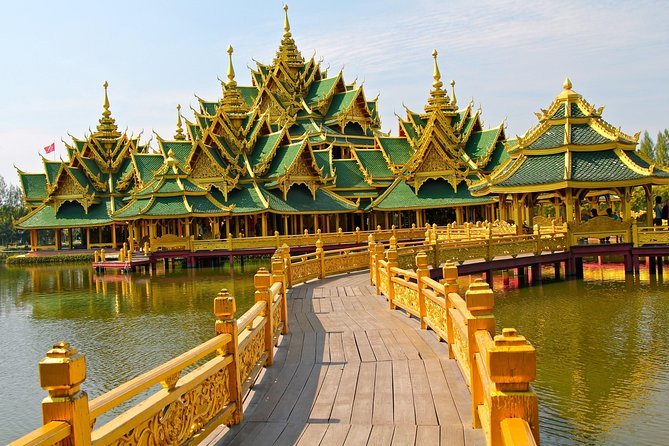
Location: Samut Prakan
Distance from Bangkok: ~1 hour
Technically a historical park, Muang Boran features full-scale replicas of Thailand’s most important landmarks, spread across a beautifully landscaped area. Walking or cycling through the site offers a unique blend of nature, history, and culture.
Nestled just a short drive from Bangkok, Samut Prakan Ancient City, also known as Muang Boran, is a sprawling open-air museum that offers visitors an immersive experience into Thailand's diverse culture, history, and architectural heritage. As one of the largest outdoor museums in the world, it provides a unique opportunity to explore Thailand's most iconic landmarks in miniature form, all set within a lush, scenic landscape.
For history buffs, culture enthusiasts, and those looking for a day trip from Bangkok, Muang Boran is an absolute must-visit destination that combines artistry, history, and nature.
Overview of Samut Prakan Ancient City (Muang Boran)
- Location: Samut Prakan Province, approximately 30 kilometers southeast of central Bangkok
- Established: 1963
- Size: Over 200 acres (80 hectares)
- Highlight: Replicas of Thailand's most iconic historical and cultural landmarks
- Entry Fee: 350 THB for adults, 175 THB for children (as of the latest updates)
Muang Boran, or The Ancient City, was founded by Phya Bhirom Bhakdi, the patriarch of the Chang Brewery family, as an endeavor to preserve Thailand’s heritage and showcase its traditional art and architecture. The park offers a comprehensive, yet accessible, look at the country’s cultural diversity, from ancient temples to palaces, and from rural villages to intricate royal monuments.
Key Attractions at Samut Prakan Ancient City
Miniature Replicas of Iconic Thai Landmarks
Muang Boran's most remarkable feature is its impressive collection of miniature replicas of iconic Thai landmarks. Spread throughout the park are detailed models of temples, palaces, and structures that represent the rich history of Thailand. Some notable replicas include:
- The Temple of the Emerald Buddha (Wat Phra Kaew): One of Thailand’s most revered temples, this stunning replica mirrors the original in both size and design.
- The Grand Palace: A majestic replica of the Royal Palace complex in Bangkok, capturing the grandeur of Thai architecture.
- Phimai Historical Park: A faithful reproduction of the famous Khmer-style temples found in Nakhon Ratchasima.
- The Sanctuary of Truth: A magnificent wooden structure in Pattaya, presented in a smaller form at the park.
These models not only provide visitors with a unique opportunity to admire Thailand’s architectural wonders but also serve as educational tools for understanding the evolution of Thai architecture and culture.
Scenic Gardens and Natural Beauty
Muang Boran is not just a museum of architecture; it’s also a paradise for nature lovers. The expansive park is beautifully landscaped, with lush gardens, tranquil lakes, and winding pathways perfect for leisurely strolls. Many of the replicas are set against stunning natural backdrops, with large lotus ponds and landscaped gardens enhancing the beauty of the structures.
The park’s layout mimics the traditional Thai landscape design, with flowing water, open spaces, and plenty of shady spots to rest. It’s a fantastic place to relax while soaking in the visual beauty and historical context.
Boat Ride Around the Park
One of the highlights of visiting Muang Boran is the boat ride around the park’s artificial lake. Visitors can board a traditional Thai-style boat and cruise around the park, offering a different perspective of the structures and landmarks while enjoying the scenic beauty of the area. The boat ride gives visitors a chance to experience the peaceful atmosphere of the park and enjoy the beauty of its waterways.
Exhibitions and Cultural Displays
In addition to its architectural replicas, Muang Boran offers an array of exhibitions showcasing traditional Thai arts, crafts, and historical artifacts. Visitors can learn about ancient Thai customs, religious ceremonies, and cultural practices through interactive exhibits and displays. Traditional Thai musical instruments, artwork, and historical relics are also on display throughout the park, adding depth to the cultural experience.
Best Way to Explore Muang Boran
Walking Tour
While the park is vast, it’s designed with visitors in mind, with well-maintained walkways, shady spots, and clear signage. The best way to explore is on foot, as this allows you to truly appreciate the intricacies of each structure, the beauty of the landscape, and the overall atmosphere.
Bicycle Rental
Muang Boran offers bicycle rentals for those who prefer a faster pace. With wide, paved roads and scenic routes, cycling is a comfortable and enjoyable way to explore the park.
Tram Tour
For a more relaxing and informative experience, the park offers tram tours. These tours are guided by knowledgeable staff and are a great option for those who may not want to walk or bike through the entire park.
Why Visit Samut Prakan Ancient City?
- A Unique Cultural Experience: Muang Boran offers a rare opportunity to experience Thailand’s rich culture and heritage in one location, with each replica telling a story of the country’s past.
- Family-Friendly: With its expansive grounds, peaceful atmosphere, and educational exhibits, Muang Boran is perfect for families looking to introduce children to Thailand’s history and culture.
- Photographer’s Paradise: The park’s striking architecture, scenic landscapes, and serene lakes provide endless opportunities for photography.
- Escape from the City: Just a short drive from Bangkok, the park offers a peaceful retreat from the bustle of the capital.
How to Get There
- By Car: Muang Boran is approximately 30–40 minutes from central Bangkok via Sukhumvit Road. The park is well-signposted, and there is plenty of parking available.
- By Taxi: A taxi ride from central Bangkok is a convenient option, though it may be more costly than public transport.
- By Public Transport:
- 1. Take a BTS Skytrain to Bang Na Station, then hire a taxi to the park.
- 2. Alternatively, minivans or public buses heading to Samut Prakan can drop you near the park.
Visitor Information
- Opening Hours: Daily from 9:00 AM – 5:00 PM
- Entry Fee: 350 THB for adults, 175 THB for children
- Facilities:
- 1. On-site restaurants and food stalls
- 2. Restrooms and water stations
- 3. Gift shops selling souvenirs and local crafts
- 4. Wheelchair access available in most areas
Why it’s great for families: Easy terrain, cultural learning opportunities, and picturesque views.
Tips for a Successful Family Hike Near Bangkok
- Start early to avoid the midday heat.
- Bring water, snacks, and sun protection.
- Wear proper footwear suitable for walking.
- Insect repellent is a must, especially for forested areas.
- Always check the weather forecast before heading out.

